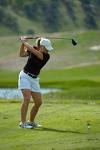 This is a series on arm and hand pain. If you missed the beginning, go back to the “Checklist of Causes.”
This is a series on arm and hand pain. If you missed the beginning, go back to the “Checklist of Causes.”
Golf elbow, medically known as medial epicondylitis, is pain at the inner elbow, usually from inflammation of the tendons that attach to it.
The muscles that hurt are mostly local: 1) the tendons of the two layers of flexors of the fingers and wrist, and 2) the triceps. Trigger Points can also cause pain, referring from the triceps and the pectoralis major in the chest.
Playing golf involves holding the club in both hands with the wrists angled toward the handle of the shaft in stance. This position deviates the wrist toward the pinkie side of the hand using the ulnar flexor muscles of the wrist. (The ulna bone goes from the inner side of the wrist to the tip of the elbow.) Gripping the club uses the flexors of the fingers. All of the flexor muscles attach via tendons to the medial epicondyle (the inner part of the dogbone end of the humerus of the upper arm).
The golf swing requires that the arms be held straight with the wrist cocked at the beginning and for part of the follow-through of the swing, and both arms straight when the ball is hit. Straight arms require contraction of the triceps on the back of the upper arm. The force of hitting the ball causes momentary increased muscle tension. Repetitive use, especially without attention to proper form, as well as excessive gripping of the handle when playing produces microtears in the tendons that attach the flexor muscles to the bone. The microtrauma causes inflammation.
The force of hitting the ball causes momentary increased muscle tension. Repetitive use, especially without attention to proper form, as well as excessive gripping of the handle when playing produces microtears in the tendons that attach the flexor muscles to the bone. The microtrauma causes inflammation.
The golf swing also requires contraction of the chest muscles, holding the arms straight and with the hands together at stance, then fully shortened when the arm is across the chest at the beginning and end of the swing.

 The pectoral muscles can cause Trigger Points that refer pain to the elbow.
The pectoral muscles can cause Trigger Points that refer pain to the elbow.
One of the triceps TrPs also refer pain to the inner elbow and down the arm.
Conservative treatment involves Active Isolated Stretching to release contractions, icing to calm the inflammation of tendonitis, and treatment of Trigger Points and tension in the involved muscles with a specific muscle therapy like Neuromuscular Therapy to relieve local and referred pain.